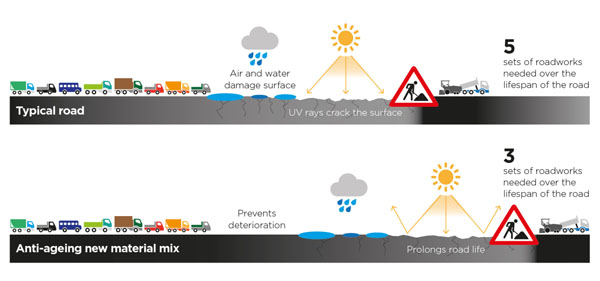Developers of a new blend of materials described as 'an anti-ageing cream for roads' say it could cut repairs and environmental impacts.
Roads on the strategic network are expected to be resurfaced every 10-12 years because water, sun and air, combined with the weight of heavy traffic, cause the surface to deteriorate and crack.

However, Highways England, working with Tarmac and Total, has resurfaced a busy section of the A43 near Silverstone, in Northamptonshire, with the new asphalt mix, which is designed to help roads last significantly longer.
The mix is held together by a new bitumen called Styrelf Long Life, which is designed to be more resistant to the elements by oxidising more slowly. This slower process means that the road surface stays flexible for longer, preventing cracks forming.
Brian Kent, technical director at Tarmac, said: ‘What we have in this case is essentially an anti-ageing cream for roads – just as these products are designed to reduce and prevent the signs of fine lines and overall ageing of the skin, the new bitumen being trialled on the A43 will protect the road surface.
‘It not only has the potential to offer improved value for money to the public purse, but it also contains properties to increase the overall lifespan of roads. Through preventing cracks to the surface of the road caused by elements such as air and water, the longer life bitumen has the ability to reduce disruption, deliver long-term carbon savings and importantly help network operators to better manage their assets.’
Highways England’s chief highways engineer, Mike Wilson, said: ‘We’re always looking for innovative ways to help us keep England’s motorways and major A-roads in good condition.
‘The ultimate priority for us is safety so we invest in new technology and materials to keep those using the roads safe.’
Rick Ashton, market development manager at Total, said: ‘These long-life binders will ultimately lead towards our vision of net zero carbon by 2050 by reducing roadworks, saving manufacturing, transport and installation energy and the associated emissions.
‘This trial paves the way for enhanced highways asset management and predictive deterioration modelling for Highways England.’
The new material has previously been tested in Total’s laboratories, at Tarmac’s site in Elstow in Bedfordshire, and on sections of road in The Netherlands.
Experts from Total will regularly measure the performance of the material against an equivalent control section laid at the same time on the A43.

The April issue of Highways has an article by Total’s Rick Ashton and Gary Schofield on the company’s work on the sustainability and durability of asphalt additives.




